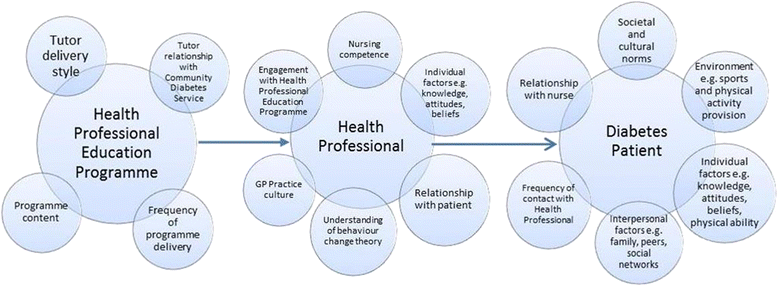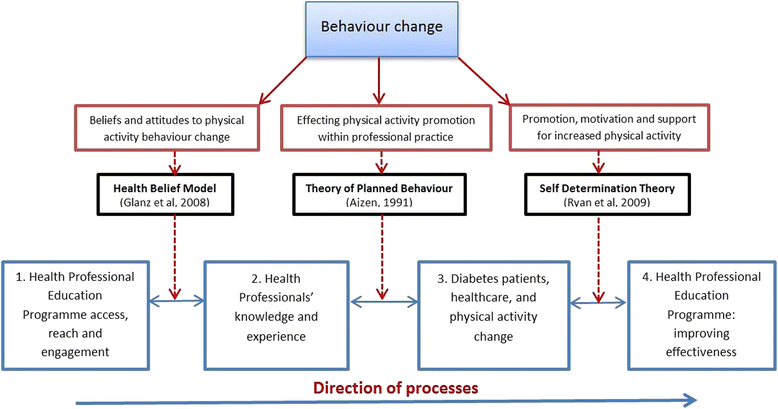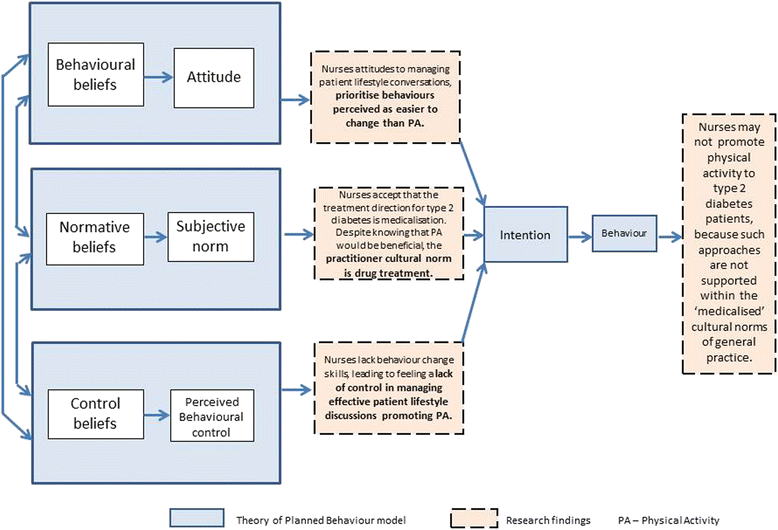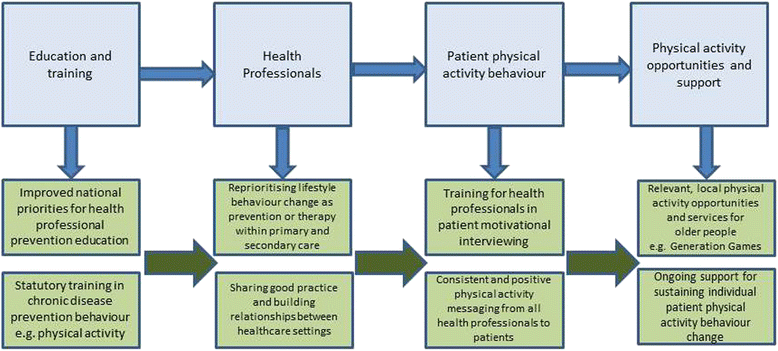An education programme influencing health professionals to recommend exercise to their type 2 diabetes patients - understanding the processes: a case study from Oxfordshire, UK
- PMID: 28187718
- PMCID: PMC5303248
- DOI: 10.1186/s12913-017-2040-7
An education programme influencing health professionals to recommend exercise to their type 2 diabetes patients - understanding the processes: a case study from Oxfordshire, UK
Abstract
Background: Increasing levels of physical activity decreases the risk of premature mortality associated with chronic diseases e.g., coronary heart disease, type 2 diabetes, stroke. Despite this, most adults in England do not meet physical activity guidelines. Physical activity advice and signposting offered to at-risk patients by primary care providers is recommended. However, exercise medicine education is sparse, leading to poor practitioner knowledge of the risk reduction evidence and strategies to implement effective patient behaviour change. The 'Generation Games' intervention seeks physical activity increase in the 50+ population of Oxfordshire. It offers a Health Professional Education Programme (HPEP) providing exercise medicine education, and promotion of Generation Games to which health professionals can signpost patients. There is a poor evidence base concerning how such education translates into patient exercise behaviour change.
Methods: The research aimed to create more understanding of how an education programme can influence health professionals to recommend Generation Games to and increase exercise behaviour in type 2 diabetes patients. A case study method facilitated examination of the routines and cultures studied - the experience of Diabetes nurses was used as an example of best practice engagement with the HPEP. Observation, interviews and documentation were employed to triangulate data. Data analysis refined and developed themes within key theoretical frameworks.
Results: Firstly, there is a lack of knowledge about physical activity risk reduction benefits and a belief that efforts to motivate patients to increase their physical activity are ineffective, thus creating barriers to engagement with the HPEP. Secondly, practice nurses tasked with delivering lifestyle advice to diabetes patients - themselves suffering a motivational interviewing skill deficit - find ingrained physical activity behaviours extremely challenging, and therefore highly value the HPEP for providing helpful tools. Thirdly, patients who hear of Generation Games from a health professional may have mismatched expectations of how their exercise behaviour can change.
Conclusions: Exercise medicine education has the potential to improve patient care and services. Before initiatives like the HPEP can succeed, primary care practice requires a more supportive exercise medicine culture. Also necessary is adequate resourcing of patient-centred behaviour change advice, training, encouragement and monitoring services.
Keywords: Behaviour change; Exercise; Health professional; Medical education; Type 2 diabetes.
Figures







Similar articles
-
Promoting and supporting self-management for adults living in the community with physical chronic illness: A systematic review of the effectiveness and meaningfulness of the patient-practitioner encounter.JBI Libr Syst Rev. 2009;7(13):492-582. doi: 10.11124/01938924-200907130-00001. JBI Libr Syst Rev. 2009. PMID: 27819974
-
Structured, intensive education maximising engagement, motivation and long-term change for children and young people with diabetes: a cluster randomised controlled trial with integral process and economic evaluation - the CASCADE study.Health Technol Assess. 2014 Mar;18(20):1-202. doi: 10.3310/hta18200. Health Technol Assess. 2014. PMID: 24690402 Free PMC article. Clinical Trial.
-
Behavioural modification interventions for medically unexplained symptoms in primary care: systematic reviews and economic evaluation.Health Technol Assess. 2020 Sep;24(46):1-490. doi: 10.3310/hta24460. Health Technol Assess. 2020. PMID: 32975190 Free PMC article.
-
'We're all in the same boat': A qualitative study on how groups work in a diabetes prevention and management programme.Br J Health Psychol. 2019 Nov;24(4):787-805. doi: 10.1111/bjhp.12379. Epub 2019 Jul 4. Br J Health Psychol. 2019. PMID: 31273908 Clinical Trial.
-
Impact of a social prescribing intervention in North East England on adults with type 2 diabetes: the SPRING_NE multimethod study.Public Health Res (Southampt). 2023 Mar;11(2):1-185. doi: 10.3310/AQXC8219. Public Health Res (Southampt). 2023. PMID: 37254700
Cited by
-
Positive reinforcement by general practitioners is associated with greater physical activity in adults with type 2 diabetes.BMJ Open Diabetes Res Care. 2019 Nov 19;7(1):e000701. doi: 10.1136/bmjdrc-2019-000701. eCollection 2019. BMJ Open Diabetes Res Care. 2019. PMID: 31803479 Free PMC article.
-
Type 2 Diabetes Mellitus and Cardiometabolic Prospects: A Rapid Narrative Review.Cureus. 2024 Jul 30;16(7):e65808. doi: 10.7759/cureus.65808. eCollection 2024 Jul. Cureus. 2024. PMID: 39092382 Free PMC article. Review.
-
Healthcare Professionals' Application and Integration of Physical Activity in Routine Practice with Older Adults: A Qualitative Study.Int J Environ Res Public Health. 2021 Oct 26;18(21):11222. doi: 10.3390/ijerph182111222. Int J Environ Res Public Health. 2021. PMID: 34769742 Free PMC article.
-
Effectiveness of health education intervention on diabetes mellitus among the teachers working in public sector schools of Pakistan.BMC Endocr Disord. 2022 Jul 30;22(1):194. doi: 10.1186/s12902-022-01110-7. BMC Endocr Disord. 2022. PMID: 35907838 Free PMC article.
-
Healthcare Professionals Promotion of Physical Activity with Older Adults: A Survey of Knowledge and Routine Practice.Int J Environ Res Public Health. 2021 Jun 4;18(11):6064. doi: 10.3390/ijerph18116064. Int J Environ Res Public Health. 2021. PMID: 34199893 Free PMC article.
References
-
- Joint Health Surveys Unit . Health Survey for England 2012: Health, social care and lifestyles. Leeds: The Information Centre; 2013.
-
- Royal College of Physicians. Falling Standards, broken promises: report of the national audit of falls and bone health in older people 2010. 2011. https://www.rcplondon.ac.uk/file/4356/download?token=GEWifpJb. Accessed 23 Jan 2017.
-
- Hauner H, et al. Obesity and Diabetes. In: Holt RIG, Cockram CS, Flyvbjerg A, et al., editors. Textbook of Diabetes. 4. Oxford: Wiley-Blackwell; 2010.
-
- Diabetes UK. Position statement: Prevention of Type 2 diabetes: reducing risk factors. 2012. https://www.diabetes.org.uk/Documents/Position%20statements/diabetes-uk-.... Accessed 27 June 2016.
MeSH terms
LinkOut - more resources
Full Text Sources
Other Literature Sources
Medical

